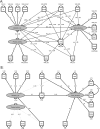Systemic inflammation as a predictor of brain aging: Contributions of physical activity, metabolic risk, and genetic risk
- PMID: 29357308
- PMCID: PMC5954991
- DOI: 10.1016/j.neuroimage.2017.12.027
Systemic inflammation as a predictor of brain aging: Contributions of physical activity, metabolic risk, and genetic risk
Abstract
Inflammatory processes may contribute to risk for Alzheimer's disease (AD) and age-related brain degeneration. Metabolic and genetic risk factors, and physical activity may, in turn, influence these inflammatory processes. Some of these risk factors are modifiable, and interact with each other. Understanding how these processes together relate to brain aging will help to inform future interventions to treat or prevent cognitive decline. We used brain magnetic resonance imaging (MRI) to scan 335 older adult humans (mean age 77.3 ± 3.4 years) who remained non-demented for the duration of the 9-year longitudinal study. We used structural equation modeling (SEM) in a subset of 226 adults to evaluate whether measures of baseline peripheral inflammation (serum C-reactive protein levels; CRP), mediated the baseline contributions of genetic and metabolic risk, and physical activity, to regional cortical thickness in AD-relevant brain regions at study year 9. We found that both baseline metabolic risk and AD risk variant apolipoprotein E ε4 (APOE4), modulated baseline serum CRP. Higher baseline CRP levels, in turn, predicted thinner regional cortex at year 9, and mediated an effect between higher metabolic risk and thinner cortex in those regions. A higher polygenic risk score composed of variants in immune-associated AD risk genes (other than APOE) was associated with thinner regional cortex. However, CRP levels did not mediate this effect, suggesting that other mechanisms may be responsible for the elevated AD risk. We found interactions between genetic and environmental factors and structural brain health. Our findings support the role of metabolic risk and peripheral inflammation in age-related brain decline.
Keywords: AD; Alzheimer's disease; Brain structure; Brain volume; C-reactive protein; CRP; Cholesterol; Cognitive aging; Cortical thickness; Gene; Genetic risk; Inflammation; Insulin; Metabolic risk; Neuroinflammation; Obesity; Physical activity; Polygenic risk score.
Copyright © 2018 Elsevier Inc. All rights reserved.
Conflict of interest statement
No author has any real or perceived conflict of interest with the work presented here. The content is solely the responsibility of the authors and does not necessarily represent the official views of the National Institutes of Health.
Figures


References
-
- Ahmad I, Zhan M, Miller M. High prevalence of C-reactive protein elevation with normal triglycerides (100–149 mg/dL): are triglyceride levels below 100 mg/dL more optimal in coronary heart disease risk assessment? Am. J. Med. Sci. 2005;329:173–177. - PubMed
-
- Akiyama H. Inflammation and Alzheimer's disease. Neurobiol. Aging. 2000;21:383–421. https://doi.org/10.1016/S0197-4580(00)00124-X. - DOI - PMC - PubMed
-
- Alberti KGMM, Zimmet P, Shaw J. Metabolic syndrome—a new world-wide definition. A consensus statement from the international diabetes federation. Diabet. Med. 2006;23:469–480. https://doi.org/10.1111/j.1464-5491.2006.01858.x. - DOI - PubMed
-
- Barnes J, Ridgway GR, Bartlett J, Henley SMD, Lehmann M, Hobbs N, Clarkson MJ, MacManus DG, Ourselin S, Fox NC. Head size, age and gender adjustment in MRI studies: a necessary nuisance? Neuroimage. 2010;53:1244–1255. https://doi.org/10.1016/j.neuroimage.2010.06.025. - DOI - PubMed
Publication types
MeSH terms
Substances
Grants and funding
- RF1 AG041915/AG/NIA NIH HHS/United States
- P50 AG005142/AG/NIA NIH HHS/United States
- U01 HL080295/HL/NHLBI NIH HHS/United States
- U01 HL130114/HL/NHLBI NIH HHS/United States
- HHSN268201200036C/HL/NHLBI NIH HHS/United States
- N01 HC055222/HL/NHLBI NIH HHS/United States
- R01 AG023629/AG/NIA NIH HHS/United States
- N01 HC085081/HL/NHLBI NIH HHS/United States
- P41 EB015922/EB/NIBIB NIH HHS/United States
- N01 HC085080/HL/NHLBI NIH HHS/United States
- N01 HC085082/HL/NHLBI NIH HHS/United States
- R01 AG040060/AG/NIA NIH HHS/United States
- HHSN268200800007C/HL/NHLBI NIH HHS/United States
- N01 HC085086/HL/NHLBI NIH HHS/United States
- N01 HC085083/HL/NHLBI NIH HHS/United States
- N01 HC085079/HL/NHLBI NIH HHS/United States
- P50 AG005133/AG/NIA NIH HHS/United States
LinkOut - more resources
Full Text Sources
Other Literature Sources
Medical
Research Materials
Miscellaneous

